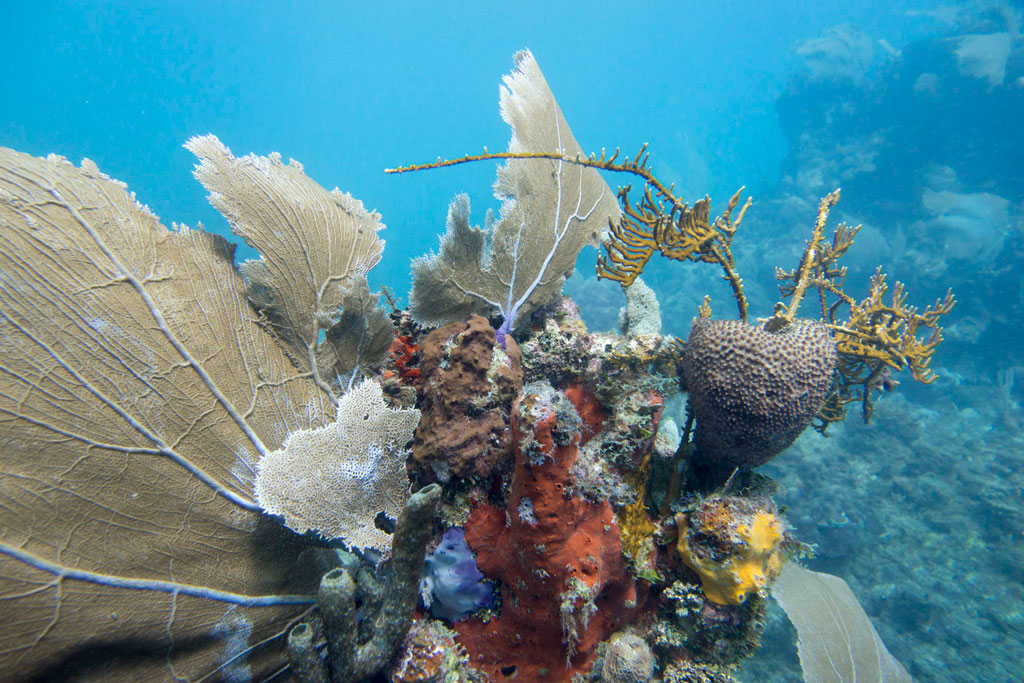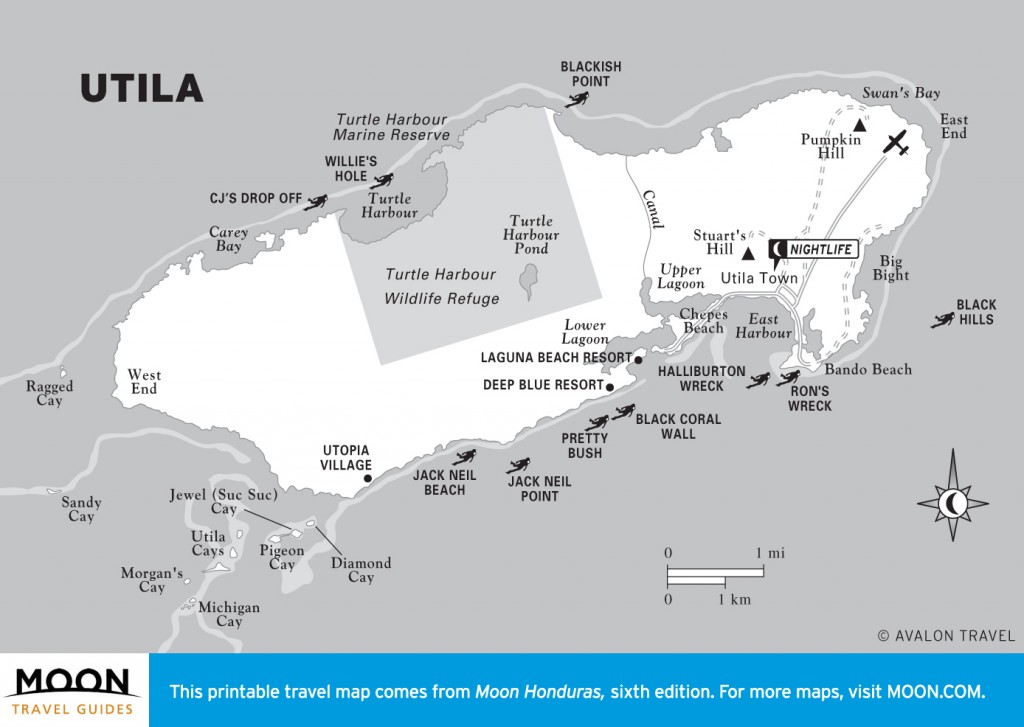
Exploring the stunning reefs around Utila in the Bay Islands. Photo © Keith Levit/123rf.
Utila feels lost in a tropical time warp. Listening to the broad, almost incomprehensible Caribbean English coming out of islanders with names like Morgan and Bodden, it seems pirates ran amok here just a few years back instead of three centuries ago. Life on Utila still moves at a sedate pace; local conversation (imbued with an island lilt) is dominated by the weather, the state of the fishing industry, and spicy gossip about the affairs of the 2,800 or so inhabitants. With its semiofficial designation as the low-budget Bay Island, Utila has become one of those backpacker hot spots like Zipolite or Lake Atitlán…In the past couple of decades, Utila has gradually come face to face with the modern day. A steadily growing stream of budget travelers flow in from across the globe, all eager to get scuba certification for as little money as possible (about US$300 in early 2012, including dorm-style accommodations) and to enjoy the balmy Caribbean waters and famed reef. With its semiofficial designation as the low-budget Bay Island, Utila has become one of those backpacker hot spots like Zipolite or Lake Atitlán—packed with young Europeans and Americans out for a good time in the sun. Utila is also well known among sea-life enthusiasts as one of the best places in the world to see the whale shark, the largest fish in the world. These monstrous creatures, getting as big as 15 meters, frequent the Cayman Channel right off Utila and can be spotted (with much patience and a good captain) frequently throughout the year, and particularly in April, May, August, and September.The sands and sea and laid-back lifestyle have persuaded many a visitor to stay, and the resident expat community is large and diverse, with some staying for a few months, and others for a few decades. The island is full of quirky characters, and welcoming of newcomers—the kind of place where everyone knows your name.

Utila
Timing can be hugely important in making sure that you have the vacation you were looking for in Utila. The rainy season stretches from mid-September to mid-December, with the heaviest rains in October. Visibility is lower when diving during this season, but reasonable, while snorkeling can be flat-out unappetizing due to the colder weather. If you do visit during the rainy season, you can take advantage of lower hotel prices and deals at dive shops, especially for walk-in customers. Bring a pair of Crocs or other rubber clogs too; regular shoes will get muddy and wet, while flip-flops fling droplets of sandy mud up the backs of your calves while you walk. The hottest months tend to be April and May.
No matter what season it is, “no-see-ums,” or sand flies, are voracious on Utila. Unfortunately, they don’t respond to much other than DEET products, which can damage the coral—and that’s what you came here for, isn’t it? If you do use DEET, be sure to rinse off before getting into the water. Alternatively, try a natural bug repellent (many are sold online in the United States and in souvenir shops on Roatan, but they’re harder to find in Utila), or slather your legs with baby oil (the local trick for keeping bugs away). Sand flies tend to be thickest in August and September.
The opportunity to snorkel with whale sharks is one of those once-in-a-lifetime travel experiences and, for many, the reason they choose Utila over any other Caribbean island…The opportunity to snorkel with whale sharks is one of those once-in-a-lifetime travel experiences and, for many, the reason they choose Utila over any other Caribbean island—whale sharks are frequent visitors on the island’s north coast. That said, no matter what any hotel or dive shop claims, there is never a guarantee about spotting one, even during the April–May whale shark high season.Many businesses cater to low-budget travelers, and many of those offer excellent values for their services, be it a dive course, US$10 hotel room, or luscious fish dinner. More recently, slightly more upscale visitors have started arriving, and local hotels and restaurants are beginning to increase their services to this market as a result. But the international backpacker party scene is as strong as ever and will undoubtedly continue for years to come. The majority of backpackers are European, although there are large American and Canadian contingencies as well.
The smallest of the three main Bay Islands, Utila is 11 kilometers long and 5 kilometers wide, with two-thirds of its area covered by swamp. Two small hills on the eastern part of the island, Pumpkin Hill and Stuart’s Hill, are volcanic in origin. There are a few golden sand beaches, but not as many as on the other islands.
As in Roatan, the Utila reef is under threat from fishermen and careless divers, to say nothing of water pollution. But without the steep hillsides of Roatan and still plenty of undrained wetlands, Utila is not likely to face as serious a water quality problem, at least not in the near future. The Bay Islands Conservation Association (BICA) in Utila patrols the entire reef around the island, with the exception of the shallow waters around the cays, where only local residents are allowed to fish. BICA also pays for environmental education in schools and sets up mooring buoys for diver boats.
Utila’s name reputedly derives from a contraction of ocotillo, which in Nahuatl refers to a place with a lot of black smoke. The smoke is thought to have come from burning the resinous ocote pine, supposedly used by pre-Columbian islanders in a type of distilling process.
A good general source of information about Utila can be found at About Utila, which includes descriptions of dive sites and current average dive prices, as well as information about hotels, restaurants, and other businesses. The BICA website also has information on the environment of the island and the reef.
Utila hosts its annual Carnaval the last full week of July. There are cultural and sporting events, a community bonfire at Chepes Beach, and various street parties held in local neighborhoods. Restaurants stay open later, and a few bars even stay open 24 hours a day. If you have a particular accommodation in mind, it’s best to reserve well in advance, but the smallest hotels do not typically take reservations, and there’s always a room to be found. Other peak times are Easter, Christmas, and the first weekend in August, when the islet of Water Cay is host to the massive music festival SunJam.
Excerpted from the Sixth Edition of Moon Honduras.